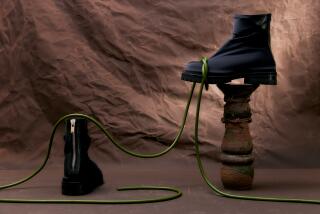Pedal to the Metal
- Share via
DETROIT — In the go-go 1980s, owning a Mercedes-Benz or BMW was the height of fashion for the conspicuous-consumption crowd. Then came the stock market crash, the luxury tax, a recession and, most important, Japanese rivals.
First Honda with its Acura luxury line, and then Toyota with Lexus and Nissan with Infiniti introduced a new level of quality, value and customer pampering to American shores.
It wasn’t long before the Benz and Bimmer set became born-again consumers, looking beyond Euro performance and prestige to a new Asian benchmark of luxury and quality at more reasonable prices.
“We got a bit complacent and took our success for granted,” recalls Victor Doolan, president of BMW of North America.
As their sales slumped in the early 1990s, the Europeans swallowed their pride, stifled their hauteur and retreated to the drawing board. They cut costs and prices, improved customer service and introduced stylish vehicles with more of the creature comforts desired by upscale U.S. drivers.
Today the Europeans, most notably the German auto makers, are again thriving in the U.S. market. As overall U.S. auto sales increased 4.3% in the first seven months of this year, sales of European models went up 10.8%.
In California, the nation’s largest luxury car market, the Europeans own a 9.5% market share, up a full percentage point from a year ago.
“The Europeans have made a tremendous comeback,” said Chris Cedergren, an independent auto consultant in Thousand Oaks. “There is more growth ahead for them.”
Their fresh success can be traced to the wake-up call delivered by the Japanese at the turn of the decade. It came in the form of the 1990 Lexus LS400.
When unveiled, the Lexus was priced $7,000 to $15,000 less than for comparable Mercedes and BMW models. Just as important, industry surveys show the Lexus had better quality and its dealers offered better service.
“It was a very good product at an unbelievable price,” said Joe Eberhardt, general manager of product management and marketing for Mercedes-Benz of North America.
Today, the bulk of the European gains are coming at the expense of the Japanese, who compete most directly for the same affluent under-55 consumer.
The Japanese lost their way when the strong yen forced the prices of their luxury sedans higher in this country, analysts say. The seminal Lexus LS400, for instance, went from a base price of $35,000 in 1990 to $53,000 this year.
Japanese vehicles also are seen by car buffs as less appealing in styling and handling than the European autos. Enthusiasts talk passionately of BMWs and Mercedes-Benzes as driving machines, and Lexus and Infinitis as mundane if first-rate appliances.
As a result, the Japanese luxury brands are struggling. Infiniti sales are down 18.9% this year from last, and Lexus sales are flat. Acura has reported a 12% sales gain, but the Honda division has moved so down-market that some analysts no longer consider it a luxury brand.
As for Detroit, the clientele for Cadillac and Lincoln, which have both struggled for sales recently, is generally older than the motorists targeted by imports. Cadillac will soon enter the fray, however, with the entry-level $30,000 Catera, a German-built Opel-based sedan.
Not that anyone is writing off Honda, Toyota and Nissan as competitors. The three are reducing costs rapidly while bringing out new products likely to make them more competitive into the next century.
“The Japanese are just now getting religion, much as the Europeans did in the early 1990s,” said Douglas Scott, president of Allison-Fisher, auto marketing research consultants in Southfield, Mich.
Clearly the Japanese have some hurdles to overcome. Among them is Jeff Davis, a Los Angeles securities broker who recently went shopping for a luxury car. He looked at Lexus and Infiniti but found them wanting next to the BMWs, Saabs and Audis he test-drove.
“The Lexus was nice but at $45,000 was way too expensive,” he said. “The Infiniti was too dull.”
He settled on a $30,000 BMW 328is. Davis said the BMW has the most power, was the best handling and was the most fun to drive. “It blew the others away,” he said.
The entire luxury car market--roughly those autos priced above $25,000--shrank in the early 1990s. More recently, well-heeled buyers have been opting for Jeep-style vehicles. But as the baby boom generation ages, the luxury segment is expected to grow modestly over the next five years.
That bodes well for the Europeans, who have built on their strong traditional brand images and brought out a steady stream of high-performance, distinctive vehicles--BMW’s 3-, 5-, and 7-Series and Z3 roadster; Mercedes’ C-Class and E-Class; and Audi’s A4 and A6.
Mercedes’ strategy typifies those of other European firms. Forced to reevaluate its position in the U.S. market, the premier German luxury-car maker determined it had the best car from an engineering standpoint but not from a consumer viewpoint.
For the first time, it began tailoring its vehicles to U.S. tastes: automatic transmissions, better sound systems, even cup holders. It cut production costs, enabling it to lower prices by thousands of dollars. It worked with dealers to improve its relationship with customers. And it launched an aggressive product program that extends the Mercedes nameplate beyond its signature sedan lineup to the SLK roadster and its first sport-utility vehicle, both arriving as 1997 models.
Mercedes sales are running 15.6% ahead of last year. Sales of its mid-range E-Class sedan--starting at $40,000--are up 62%.
At BMW, despite a shortage of vehicles, the company this year is likely to surpass sales of more than 100,000 vehicles for the first time ever in the United States. Sales are strong across its entire lineup.
The biggest surprise, however, is Audi. Audi, Volkswagen’s luxury marque, is enjoying a 50% sales bump this year. Many buyers are former owners of Japanese makes. The sales are the highest since 1988, when the company began to reel from reports of a sudden acceleration problem--later proved unfounded--in its 5000 sedan.
“About half our new buyers owned Japanese brands previously,” said Ken Moriarity, marketing director of Audi of America.
For similar reasons, other European makers are thriving as well in the U.S. market. Sales of Porsche, Saab, Volkswagen and Land Rover--now owned by BMW--are all up this year. Only Jaguar and Volvo have seen small sales declines this year.
Can they sustain this pace? The test will come when the Japanese regroup.
“The next couple of years will be very competitive in the luxury segment,” Eberhardt said. “We have been humbled once, and we do not plan to be humbled again.”
(BEGIN TEXT OF INFOBOX / INFOGRAPHIC)
Europeans Ride High Again
After stumbling in the early 1990s, European auto makers have regained their footing in the U.S. market with strong sales, largely at the expense of the Japanese. The resurgence has come as the auto makers have lowered costs and prices, improved customer service and introduced stylish products with more features that affluent Americans crave. The Germany luxury car makers have made the greatest strides.
Audi
Sales for 1996 are up 49.1% through July and are projected to be the highest since 1987. In thousands:
1996: 25.0 (Company Projections)
BMW
Sales are up 10.8% this year as the company is posed to sell more than 100,000 vehicles in the United States. In thousands: 103.0 (Company Projections).
MERCEDES-BENZ
Sales are up 15.6% this year and should continue to increase as the company introduces two mew models. In thousands:
1996: 85.0 (Company Projections)
* Sources: Audi, BMW and Mercedes-Benz.






